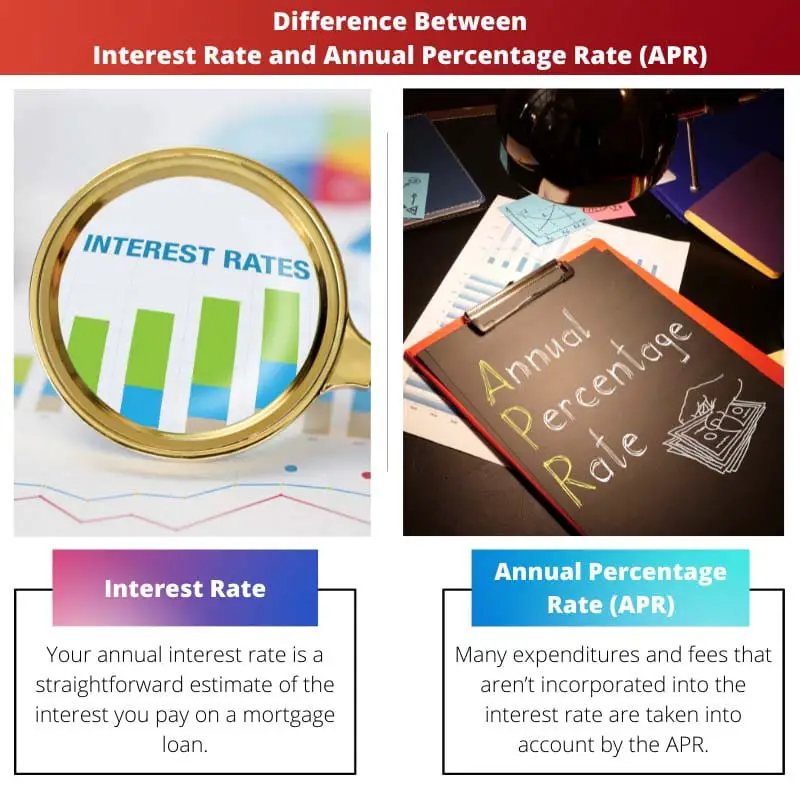You may see an Annual Percentage Rate (APR) next to the note rate while searching for a new mortgage loan.
The inclusion of an APR is required by federal law in order to provide borrowers with a consistent benchmark by which to compare the total cost of each loan.
Key Takeaways
- Interest Rate refers to the cost of borrowing money, whereas APR includes additional costs such as fees associated with the loan.
- APR gives a more accurate picture of the total cost of borrowing, as it considers all associated costs, while Interest Rate only considers the interest charged.
- Interest Rate calculates the monthly interest payment, while APR compares the overall cost of different loan options.
Interest Rate vs Annual Percentage Rate (APR)
Interest rate is the simple estimate of the interest that is paid on a mortgage loan, and it is calculated yearly, excluding any additional expenses. Annual percentage rate means the feed and expenditures that are not added to the interest rate and allow you to compare mortgage providers based on their extra fees.

The interest rate currently charged on mortgage loans is furthermore calculated by a purchaser’s credit score and commanding rates–i.e., the overall interest rate currently required by moneylenders on mortgage loans.
Interest rate is determined by your credit score, which means the greater your credit score, the more reliable it is.
The lender sets APR, which includes loan fees and other additional charges that are different from one lender to another. It equips borrowers with a more detailed view of the cost of a loan.
The Annual Percentage Rate has nothing to do with the recurrent payment, which is determined solely based on the interest rate.
Comparison Table
| Parameters of Comparison | Interest Rate | Annual Percentage Rate (APR) |
|---|---|---|
| Definition | Your annual interest rate is a straightforward estimate of the interest you pay on a mortgage loan. | Many expenditures and fees that aren’t incorporated into the interest rate are taken into account by the APR. |
| Calculation | Interest rates provide a basic calculation. | APR allows you to compare mortgage providers. |
| Main interest | Interest rates are measure to focus on. | APR prevents lenders from withholding information about certain costs. |
| Flexibility | a rate of interest Fixed, and lockable options are all available. | Only if the borrower intends to live in the house. |
| The total cost of the loan | the rate of interest Doesn’t provide you a true picture of how much a loan will cost in total. | A lower transaction cost may not always imply a lower APR. |
What is Interest Rate?
Your yearly interest rate is a simple calculation of the interest you’re paying on a mortgage loan, excluding any additional expenses. Interest rates are a few tenths of a percentage point lower than the APR.
The majority of consumers browse for lenders and evaluate loan offers based on the interest rate. However, interest rates are frequently expressed as annual rates.
You will have the lowest monthly mortgage payment if you obtain the lowest interest rate. Compare the APR rates given to you if you want to know the cumulative price of the mortgage loan.
The best annual percentage rate might not be the lowest rate or payment, but it will be the least expensive throughout the loan’s life.
The Federal Reserve, known as the Fed, sets the federal funds rate, which has an impact on investment rates. The general reserves rate is the overnight rate at which banks give savings dividends to other banks.
In a recession, for example, the Fed would lower the federal funds rate to encourage people to spend.
During periods of strong economic development, the Federal Reserve would boost interest rates over time in order to promote greater savings and balance cash flow.

What is Annual Percentage Rate (APR)?
APR stands for annual percentage rate, which is calculated on loan. This is the total amount you’ll pay over a year, including interest, lender fees, origination costs, and other expenses.
When borrowing money, the lower the APR, the less expensive it will be over time; nevertheless, this does not guarantee the lowest monthly payment.
Annual percentage rates provide a more accurate picture of how much you’re paying on your loan. Depending on whether or not points are added, the APR might be greater or lower.
Lenders frequently promote low APR rates that are artificially low due to the payment of discount points.
The APR refers to the overall interest rate from the mortgage loan as well as any additional costs spent in the loan’s acquisition.
The APR includes both the lender’s and appraisal costs, however, the lender’s expenses are sometimes included when the appraisal charge isn’t.
Simply put, it refers to the overall cost of borrowing over a year. It’s a better tool for comparing financial goods than the interest rate since it’s more complete.
It is a reliable indicator of the overall cost of the loan. It is regarded as an important guiding factor when it comes to borrowing.

Main Differences Between Interest Rate and Annual Percentage Rate (APR)
- Interest rates are a great indicator of what your monthly payment will look like, whereas APR Accounts for many of the costs and fees are not factored into the interest rate.
- Interest rates provide Standard calculation, whereas APR Provides a realistic comparison of different mortgage lenders and products.
- Interest rates are a measure to focus on. In contrast, APR Prevents lenders from not disclosing certain fees.
- Interest rate does not provide an accurate picture of the total cost of a loan, whereas A lower APR does not necessarily translate into a better deal.
- Interest rate Can be fixed or locked, whereas APR can be Optimized only if the borrower plans to stay in the property throughout the entire mortgage.

- https://heinonline.org/hol-cgi-bin/get_pdf.cgi?handle=hein.journals/hsnfnrv5§ion=16
- https://www.emerald.com/insight/content/doi/10.1108/02652320210419689/full/html

The article provides a comprehensive comparison between interest rates and APR, emphasizing the importance of understanding both when considering a mortgage loan.
My credit score has a significant impact on the interest rates I’m offered. It’s crucial to maintain good credit to secure the best rates.
The Federal Reserve’s policies play a crucial role in setting interest rates. It’s fascinating how they respond to economic changes.
I find it ironic how lenders promote low APR rates that may not accurately reflect the true cost of borrowing. It’s misleading.
I think banks should be more transparent about their APR rates. We need to know how the total cost of borrowing is truly calculated.
Understanding the APR is key for making informed decisions about mortgage loans. The more people know about it, the better choices they’ll make.
Interest rates and APR are essential for anyone seeking a mortgage loan. Understanding the differences is crucial to calculate the true cost of borrowing.
I always knew that the APR included additional costs, but it’s interesting to see how it really affects the total cost of the loan.